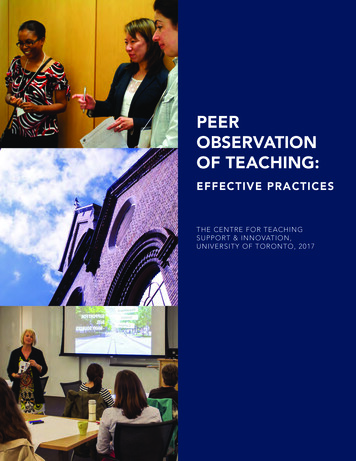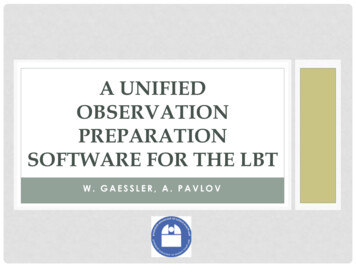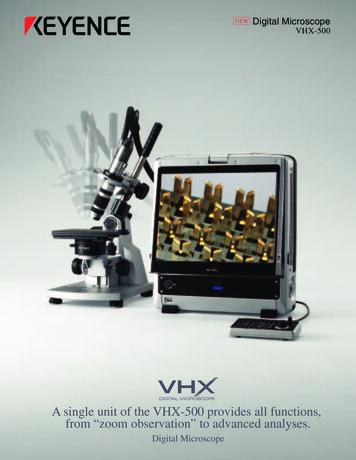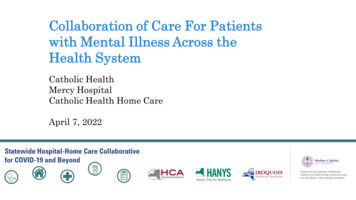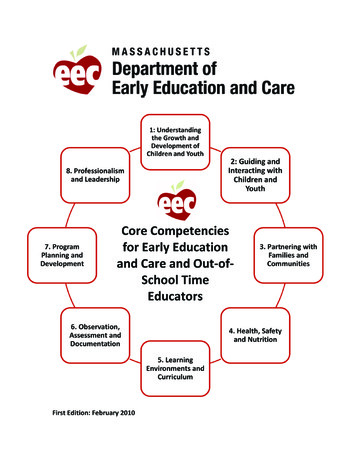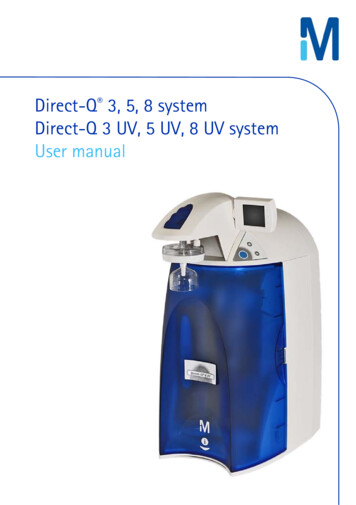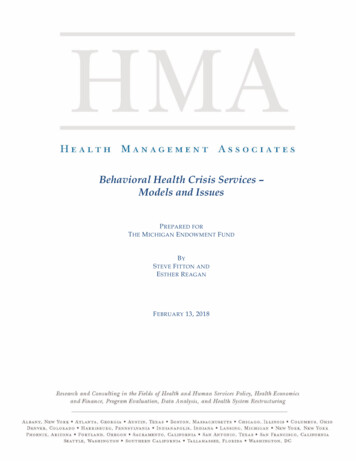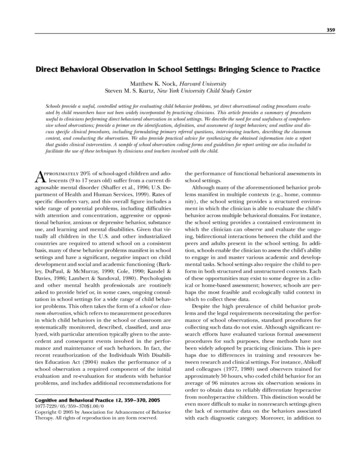
Transcription
359Direct Behavioral Observation in School Settings: Bringing Science to PracticeMatthew K. Nock, Harvard UniversitySteven M. S. Kurtz, New York University Child Study CenterSchools provide a useful, controlled setting for evaluating child behavior problems, yet direct observational coding procedures evaluated by child researchers have not been widely incorporated by practicing clinicians. This article provides a summary of proceduresuseful to clinicians performing direct behavioral observation in school settings. We describe the need for and usefulness of comprehensive school observations; provide a primer on the identification, definition, and assessment of target behaviors; and outline and discuss specific clinical procedures, including formulating primary referral questions, interviewing teachers, describing the classroomcontext, and conducting the observation. We also provide practical advice for synthesizing the obtained information into a reportthat guides clinical intervention. A sample of school observation coding forms and guidelines for report writing are also included tofacilitate the use of these techniques by clinicians and teachers involved with the child.Approximately 20% of school-aged children and adolescents (9 to 17 years old) suffer from a current diagnosable mental disorder (Shaffer et al., 1996; U.S. Department of Health and Human Services, 1999). Rates ofspecific disorders vary, and this overall figure includes awide range of potential problems, including difficultieswith attention and concentration, aggressive or oppositional behavior, anxious or depressive behavior, substanceuse, and learning and mental disabilities. Given that virtually all children in the U.S. and other industrializedcountries are required to attend school on a consistentbasis, many of these behavior problems manifest in schoolsettings and have a significant, negative impact on childdevelopment and social and academic functioning (Barkley, DuPaul, & McMurray, 1990; Cole, 1990; Kandel &Davies, 1986; Lambert & Sandoval, 1980). Psychologistsand other mental health professionals are routinelyasked to provide brief or, in some cases, ongoing consultation in school settings for a wide range of child behavior problems. This often takes the form of a school or classroom observation, which refers to measurement proceduresin which child behaviors in the school or classroom aresystematically monitored, described, classified, and analyzed, with particular attention typically given to the antecedent and consequent events involved in the performance and maintenance of such behaviors. In fact, therecent reauthorization of the Individuals With Disabilities Education Act (2004) makes the performance of aschool observation a required component of the initialevaluation and re-evaluation for students with behaviorproblems, and includes additional recommendations forCognitive and Behavioral Practice 12, 359–370, 20051077-7229/05/359–370 1.00/0Copyright 2005 by Association for Advancement of BehaviorTherapy. All rights of reproduction in any form reserved.the performance of functional behavioral assessments inschool settings.Although many of the aforementioned behavior problems manifest in multiple contexts (e.g., home, community), the school setting provides a structured environment in which the clinician is able to evaluate the child’sbehavior across multiple behavioral domains. For instance,the school setting provides a contained environment inwhich the clinician can observe and evaluate the ongoing, bidirectional interactions between the child and thepeers and adults present in the school setting. In addition, schools enable the clinician to assess the child’s abilityto engage in and master various academic and developmental tasks. School settings also require the child to perform in both structured and unstructured contexts. Eachof these opportunities may exist to some degree in a clinical or home-based assessment; however, schools are perhaps the most feasible and ecologically valid context inwhich to collect these data.Despite the high prevalence of child behavior problems and the legal requirements necessitating the performance of school observations, standard procedures forcollecting such data do not exist. Although significant research efforts have evaluated various formal assessmentprocedures for such purposes, these methods have notbeen widely adopted by practicing clinicians. This is perhaps due to differences in training and resources between research and clinical settings. For instance, Abikoffand colleagues (1977, 1980) used observers trained forapproximately 50 hours, who coded child behavior for anaverage of 96 minutes across six observation sessions inorder to obtain data to reliably differentiate hyperactivefrom nonhyperactive children. This distinction would beeven more difficult to make in nonresearch settings giventhe lack of normative data on the behaviors associatedwith each diagnostic category. Moreover, in addition to
Nock & Kurtz360diagnostic information, clinicians also need to identifythe functional determinants of the problem behaviors, aswell as the varying characteristics of the child, teachers,peers, and classroom environment that may be useful fordesigning and modifying interventions aimed at remediation of the problem behaviors. Procedures for performing these tasks are not neatly encapsulated in any existingresearch protocol available to practicing clinicians.In an effort to help fill this science-practice gap, thepurpose of this article is to provide a summary of procedures useful to clinicians performing behavioral observations with school-aged children. Rather than presenting adetailed description of any one coding system currentlyused by researchers in this area, we describe general guidelines and procedures for the implementation of a comprehensive, idiographic school observation. In doing sowe draw directly from our work developing and testingmethods for conducting behavioral observations in schools.After discussing the advantages and disadvantages of directobservation procedures, we provide a primer on the identification, definition, and assessment of child behaviorsto increase the relevance of this information for those whomay be unfamiliar with behavior observation techniques.Next, we outline and discuss specific clinical procedures,including formulating primary referral questions, interviewing the teachers, describing the classroom context,and conducting the observation. Finally, we provide practical advice for synthesizing the obtained informationinto a report that facilitates clinical intervention by clinicians, teachers, and parents involved with the child.Advantages and Disadvantages ofDirect Observation ProceduresSchool observations offer several advantages over otherassessment methods, and these advantages can greatly enhance the effectiveness and efficiency of clinical interventions. First, school observations provide a means of objective measurement of a wide range of behaviors as theyoccur in the natural environment. Indeed, observationaldata are free from most sources of bias associated with behavior rating scales such as social desirability, mood of therater, rater attributions about culture or socioeconomicstatus, and halo effects (e.g., Abikoff, Courtney, Pelham,& Koplewicz, 1993; Cohen & Kasen, 1999; Edelbrock,1988) and have been shown to better predict future adjustment than parent or teacher reports of child behavior(e.g., Patterson & Forgatch, 1995). In addition, the use ofdirect observation allows for the description and evaluation of specific behaviors. Even the most comprehensivebehavior rating scales do not contain items representingthe full range of possible behavior problems exhibited inthe school/classroom context. Also, behavioral descriptions presented in rating scales typically are vague andmore likely to introduce criterion error variance, compared with the use of direct observation methods that allowfor a more precise evaluation of the target behaviors.Second, observational data have greater external orecological validity than behavior rating scales, as theyprovide a measurement of the behavior as it is actually occurring in the school context. Third, while behavior ratingscales provide information about the frequency and severity of behavior problems, observational data also provide information about the functions of such behaviors(Hanley, Iwata, & McCord, 2003; Kazdin, 2001; Miltenberger, 1997).That is, behavioral observation can provide information about the purpose or cause of a given behavior byevaluating the antecedent and consequent events thatmaintain the target behaviors. Although rating scales designed to gather information about antecedent and consequent influences on behavior have been developed (Durand & Crimmins, 1988; Nock & Prinstein, 2004), a truefunctional behavioral assessment generally is not possiblewithout directly observing the child’s behavior. The ability to observe child behavior in a real, structured settingrepresents an important advantage of school observationover other assessment methods.Despite the advantages of using direct observationmethods, several disadvantages of this approach shouldbe noted. First, the performance of a school observationis more costly in terms of time, money, and resources thanother measurement methods such as parent-, teacher-, orchild behavior rating scales. School observations typicallyrequire at least 1 hour of direct observation in addition totime and expenses for travel, preparation, and reportwriting, compared to the relatively little time required tocomplete behavior rating scales. Clinicians should consider offering a behavioral observation in the school setting as part of initial or ongoing assessment services oras part of a larger psychological evaluation. Moreover,school observations require training and utilization ofmental health professionals, while most rating scales canbe administered and scored by nonclinical personnel. Second, the identification and evaluation of a specific behaviorduring a discrete time period may provide limited dataabout a child’s behavior in the classroom or in other settings. That is, although data from teacher ratings tend tobe more vague and global than data from direct observations, the former provide information about a wide rangeof behaviors from the entire school day. In contrast, direct observation techniques provide a narrower sampleof specific behaviors. Third, there are potential methodological problems with the use of direct observation, suchas child or teacher reactivity to the presence of the observer, observer drift, and perceptual biases of the observer(Kazdin, 1978; Skinner, Dittmer, & Howell, 2000).These advantages and disadvantages should be weighed
Behavioral Observation in Schoolswhen deciding whether a school observation is appropriate for a specific child. To be sure, all children referredfor clinical services will not require a school observation.Although school observations could always provide potentially useful clinical information, given the time andresources required and the potential limitations of thisapproach, they should generally be reserved for cases inwhich the form and/or function of a behavior problempresent in the school is unclear. We recommend a steppedmodel of assessment, in which the intensive evaluation ofspecific behavior problems should be implemented onlyafter other more global and less intensive assessmentmethods have been exhausted. This approach differs fromstepped care models of psychotherapy (e.g., Haaga, 2000),given its focus on assessment rather than intervention,and differs from multiple gating screening techniques(e.g., Loeber, 1990; van Lier, Verhulst, & Crijnen, 2003),given its focus on an individual child rather than a massscreening approach. For instance, a child with self-, parent-,and teacher-reported symptoms of obsessive-compulsivedisorder occurring consistently across multiple contextswill not require a school observation because such an assessment is not likely to add unique information. Alternatively, in a case of a child referred for aggressive and noncompliant behavior with some teachers but not others, aschool observation may be warranted as it could provideobjective, ecologically valid information about the formand function of the target behaviors that may not otherwise be accurately evaluated.Structured School Observation Coding SystemsA number of structured systems for coding direct observation data collected in school settings have been developed and evaluated over the past several decades andmay be of interest to the clinician conducting a schoolobservation. These systems can be used by the clinicianwhen they match the problem behavior and setting inquestion. Alternatively, in situations where there is not adirect match between the system and the identified problem, these systems may serve more generally as a methodological guide for structuring or implementing a moreindividualized school observation. One of the earliest andmost thoroughly evaluated systems, the Classroom Observation Code (COC; Abikoff & Gittelman, 1985), uses atime sampling procedure to classify child behaviors according to 14 observational categories. As suggested bythe different behavioral categories (e.g., interference,solicitation, off-task, physical and threats of aggression,noncompliance, motor movement, extended verbalization, daydreaming), the COC has been used primarily withhyperactive, inattentive, and disruptive children. TheCOC has adequate interobserver reliability, discriminatesbetween hyperactive and nonhyperactive children, andhas no detectable observer effect on child behavior(Abikoff et al., 1977, 1980). The application of this codingsystem has extended beyond mainstream classrooms, andits interobserver reliability and concurrent and discriminative validity have also been supported in classroom settings within psychiatric hospitals (Horn, Conners, Wells,& Shaw, 1986). Among the limitations of these findings,however, the reliability and validity estimates generatedwere based on an average of 11.6 days of observations foreach child (Horn et al., 1986), and this system has limitedgenerality beyond hyperactive behaviors in children.Another direct observation coding system that has received considerable empirical support is the School Observation Coding System (SOCS; McNeil et al., 1991) andthe subsequent Revised Edition of the School Observation Coding System (REDSOCS; Jacobs et al., 2000).1 TheSOCS and REDSOCS both use a modified time samplingprocedure and classify behaviors on three behavioral domains: (1) appropriate versus inappropriate behaviors,(2) compliant versus noncompliant behavior, and (3) ontask versus off-task behavior. The behavioral categoriesare broader than those used in the COC, and the developers of the SOCS and REDSOCS report less trainingtime required for the observer to reach performance criterion. Similar to the COC, the SOCS and REDSOCShave been used primarily with children with disruptivebehavior disorders, and studies using these measureshave supported the interobserver reliability and the concurrent and discriminative validity of these measures( Jacobs et al., 2000; McNeil et al., 1991). Although thestructured nature of the REDSOCS is among its strengths,this system too is limited in its ability to assess idiosyncratic child behaviors that may occur in school settings.Several direct observation coding systems are also offered as adjunctive components of widely used, multirater assessment packages. For example, the Child Behavior Checklist (CBCL; Achenbach, 1986) includes a DirectObservation Form (DOF) to accompany teacher-, parent-,and self-report forms. Similarly, the Behavior AssessmentSystem for Children (BASC; Reynolds & Kamphaus, 1998)includes a Student Observation System (SOS) to accompany teacher-, parent-, and self-report forms. Both of thesecoding systems are easy to learn and implement, requiring minimal training, are readily available as part of widelyused assessment packages, and sample a wide range of behavior problems (96 on the DOF and 65 on the SOS) andadaptive behaviors in a short time period (10 to 15 minutes of direct observation for each administration). However, the use of a list of predetermined behavior problems, a small time sampling period, and minimal observer1 It is our belief that a more appropriate name for this measure isthe Youth Assessment of Needs for Kids Exhibiting Emotional problems in School (YANKEES). However, we acknowledge a potentialbias, as both authors are from the New York metropolitan area.361
Nock & Kurtz362training, as well as a failure to consider functional determinants of observed behaviors, limit the information derived from the use of these measures.Clinicians should consider what type of behavioral information is desired from the observation and what resources are available when deciding what type of directobservation coding system to utilize in any given case. Ininstances where one of these systems is not appropriate(e.g., target behavior is not assessed sufficiently by thesystem), the clinician should conduct an assessmentgrounded in the principles of behavioral assessment (seeKazdin, 2001; Miltenberger, 1997; Shapiro & Kratochwill,2000). We have written previously about adapting structured, evidence-based psychosocial treatments for idiographic clinical use guided by psychological science andbehavioral assessment (Nock, Goldman, Wang, & Albano,2004), and offer here a similar approach focused moredirectly on conducting school observations. We first offera primer on behavioral assessment as it applies to children in school settings for those unfamiliar with suchmethods and their application with this population andin this setting.A Primer on Identifying, Defining, andAssessing Child BehaviorIdentify the Problem BehaviorsVia a Thorough Clinical InterviewThe valid assessment of child behavior problems requires the collection of information that spans multipledomains of functioning, informants, measurement methods, and environmental contexts (Campbell & Fiske,1959; Shapiro & Kratochwill, 2000).Multiple domains. Families often present for assessmentwith one identified “chief complaint”; however, this isnot necessarily the only area requiring intervention orthe most ideal primary treatment target. Rather than proceeding immediately with intervention, it is important toassess multiple domains of functioning in order to identify all potential areas of maladaptive and adaptive functioning and to collect information about the structureand function of each identified behavior.Multiple informants and contexts. Decades of researchhave demonstrated that interinformant agreement onthe presence and severity of child behavior problems isquite poor across various domains of functioning (e.g.,Achenbach, McConaughy, & Howell, 1987). There aremany factors contributing to this variability, including situational specificity of behavior, informant bias, methodvariance, and type of behavior problem. For example,agreement across all informants (child, peer, teacher, andparent) is generally better for externalizing compared tointernalizing problems (Edelbrock et al., 1986; Ledingham, Younger, Schwartzman, & Bergeron, 1982). In addi-tion, internalizing problems such as depressed mood,anxiety, and somatic complaints are reported more frequently by children than by their parents (Ivens & Rehm,1988; Kashani, Orvaschel, Burk, & Reid, 1985). Nevertheless, both parent- and child-report of child behaviorproblems have been shown to be significantly related tomeasures of external validation (i.e., service utilization,evidence of behavioral impairment, etc.; see Jensen et al.,1996). Taken together, these findings suggest that despitelow levels of agreement across informants, multiple informants should be used in child assessment given theunique information each provides about child behaviorin different contexts and from different perspectives.Multiple methods. Self-report procedures are typicallycharacterized by higher sensitivity for detecting constructs of interest (e.g., Prinstein, Nock, Spirito, & Grapentine, 2001), perhaps due to willingness of children andadolescents to endorse items on self-report they might behesitant to discuss in interview-based assessment. In contrast, interview-based approaches generally allow for greaterspecificity through follow-up questions. Given differentialresponding for various measurement methods, cliniciansshould employ multiple assessment methods whenever possible in order to ensure accurate identification and diagnosis of clinical behavior problems.Define the Target BehaviorsOnce a problem area has been identified, the targetbehaviors must be defined in a manner that is observable,measurable, and specific. The criterion of being observablerefers to the definition of the target behaviors in termsthat are readily apparent to more than one individual.For instance, “the number of times Johnnie kicks a classmate” satisfies the observable criterion, while “the number of times Johnnie gets angry” does not, given that“anger” refers to an affective state that is not reliably apparent between independent observers. If a behavior isconceptualized in a way that makes it observable, a measurement strategy can be devised to quantify its occurrence.Specificity refers to the precision of the defined target behaviors, such that boundary rules are established to indicate when a behavior has or has not occurred. Considerthis definition: “Kicking a classmate refers to makingphysical contact between Johnnie’s foot and any part ofanother student but does not include instances in whichJohnnie stops his foot before contact is made.” This specific definition precisely indicates when the target behaviors have occurred and when they have not.Although undesirable or maladaptive behaviors areoften the focus of assessment, as in the examples notedpreviously, the goals of clinical intervention should centeron developing replacement or alternative behaviors (Blader,Nissen, Fleiss, & Kurtz, 2000). Replacement behaviors referto the ultimately desired, adaptive behaviors that are
Behavioral Observation in Schoolsincompatible with the problem behavior. For instance, ifthe problem behavior is “punching a teacher in responseto a difficult task demand,” a replacement behavior mightbe “complying with difficult task demands while keepinghands and feet to self.”Given it is typically not expected that a child willchange directly from a problem behavior to an adaptive,incompatible behavior, it often is helpful to first developalternative behaviors, which refer to acceptable behaviorswhose performance decreases the probability the problembehavior will occur. Alternative behaviors are not necessarily incompatible with the problem behavior, and maybe approximations of the desired behavior. If the alternative behavior is functionally equivalent with the problembehavior, this may increase the probability of maintenance of the alternative behavior. However, functionalequivalence is also not a necessary criterion for the development of alternative behaviors. For instance, in the example above an alternative behavior might be “requesting apass to go to the guidance office in response to difficulttask demands.” If the function of the child’s problem behavior is determined to be avoidance of the task demand,and this alternative behavior also functions to avoid thetask demand, then the two are considered functionallyequivalent. Although not the ultimately desired outcome,leaving the room is a more acceptable behavior and considered a step closer to the desired outcome. Another alternative behavior might be “keeping hands to self in response to a difficult task demand.” In this case, the childshould be rewarded if he does not hit the teacher in response to a difficult task demand, even if he performssome other undesirable behavior such as yelling at her.Although yelling at the teacher is of course not the ultimately desired behavior, and “keeping hands to self” isnot functionally equivalent with avoiding the task demand, it is considered a closer approximation of the desired behavior than is the problem behavior and thus isconsidered a favorable alternative behavior.Define Events Related to the Target BehaviorsGiven that myriad factors in a child’s environment, internal and external, influence the occurrence of givenbehaviors, school observations will be most effective whencontextual influences are identified and measured in asystematic manner. As a general rule, in addition to defining and measuring the target behaviors, the observershould also provide a description of antecedent and consequent events associated with each target behavior.The observation should consider different types of antecedent influences, including information about potential establishing operations or setting events, discriminative stimuli, and prompts. Establishing operations and setting eventsrefer to factors that alter the value of reinforcers and thelikelihood of engaging in specific behaviors to obtainreinforcement. For instance, time of day, exhaustion, andhunger are all establishing operations that might influence child behavior (e.g., children may be more likely toperform behaviors reinforced with access to a stimulatingtoy when other toys are unavailable rather than abundant). Discriminative stimuli refer to events that indicate aparticular behavior is likely to be reinforced. For example,some behaviors may only be reinforced or punished inthe presence of a specific teacher or staff member but notothers. Prompts refer to events that directly guide or facilitate task performance, such as instructions, commands,or reminders from a teacher.The observation should also consider different typesof consequent events, including information about thepresentation or removal of different events that followthe target behaviors. The target behaviors may be followed by the presentation of a desired event (i.e., positivereinforcement), such as attention from the teacher or laughter by peers; the removal of an aversive event (i.e., negativereinforcement), such as the removal of the teacher’s demandsto go to the principal’s office; or by the lack of any event,such as being ignored by the child’s teacher and peers.Information about such antecedent and consequentevents is critical in understanding the determinants of thetarget behaviors and is useful in treatment planning. Without such data one is left without the ability to see behavioralpatterns and inevitably will either make no objective causeand-effect hypotheses or make ones that are (a) without anempirical basis, (b) likely to be less accurate and less parsimonious, and (c)lead to less efficient interventions.Assessment StrategiesOnce the target behaviors have been adequately defined, the observer must monitor the child to record theoccurrence of the behaviors, as well as the presence of antecedent and consequent events. This is in contrast to behavior rating scales, in which child, peer, teacher, or parent retrospective report is used to describe the prioroccurrence of the target behaviors. There are several different methods for recording the occurrence of the target behaviors in school observations. These methods canbe used alone, in sequence, or in combination.Descriptive method. One way the observer can recordthe occurrence of the target behaviors is simply by providing a specific description of the behavior as it is performed. In doing so, the observer should provide an objective account of the mechanics of the behavior, theamount of time the behavior is performed, and the intensity of the movements. As mentioned, the observer shouldalso describe the antecedent and consequent events surrounding each performance of the target behavior.This descriptive method typically should last at least 10to 15 minutes, depending on the frequency of the targetbehaviors, and is often most useful when the specific char-363
364Nock & Kurtzacteristics and potential determinants of the target behaviors are not yet known. An example of a coding sheetfollowing a descriptive format is presented in Figure 1. Inmany cases, it is advisable to follow the descriptive methodwith the use of a more structured, time-sampling technique, such as one of those described below, to generatemore systematic data once the potential contingencieshave been operationalized during the initial observationperiod.Checklist method. Another method for recording theoccurrence of the target behaviors is the use of checklistsin which the observer makes check marks to record various aspects of the target behavior. Behaviors typically arelisted on one axis of a recording form and time periodsor classrooms are listed on the other axis. There are several different types of checklists commonly used for direct behavioral observation.Behavior checklists refer to simple forms in which theobserver uses check marks to indicate which behaviorsfrom a long list of potential behaviors occurred duringthe observation period. For instance, the BASC-SOS(Reynolds & Kamphaus, 1998) contains a section with alist of 14 behavioral categories from which the observerindicates whether a behavior from each category occurredduring a 15-minute observation period. A variation onthe behavior checklist is frequency recording, in which theobserver indicates how often the behavior occurred usinga check mark for each instance of the behavior. An example of a frequency recording checklist is presented inFigure 2.Interval recording refers to a technique in which the observer indicates (again using check marks) whether thetarget behaviors occur during a specific time interval. Interval length varies depending on the frequency of thebehavior, the amount of time allowed for the observation,and the skill of the observer in monitoring
Structured School Observation Coding Systems A number of structured systems for coding direct ob-servation data collected in school settings have been de-veloped and evaluated over the past several decades and may be of interest to the clinician conducting a school observation. These systems can be used by the clinician

